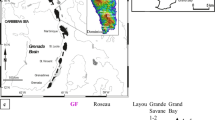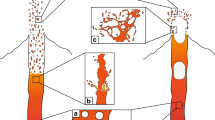Abstract
The largest products of magmatic activity on Earth, the great bodies of granite and their corresponding large eruptions, have a dual nature: homogeneity at the large scale and spatial and temporal heterogeneity at the small scale1,2,3,4. This duality calls for a mechanism that selectively removes the large-scale heterogeneities associated with the incremental assembly4 of these magmatic systems and yet occurs rapidly despite crystal-rich, viscous conditions seemingly resistant to mixing2,5. Here we show that a simple dynamic template can unify a wide range of apparently contradictory observations from both large plutonic bodies and volcanic systems by a mechanism of rapid remobilization (unzipping) of highly viscous crystal-rich mushes. We demonstrate that this remobilization can lead to rapid overturn and produce the observed juxtaposition of magmatic materials with very disparate ages and complex chemical zoning. What distinguishes our model is the recognition that the process has two stages. Initially, a stiff mushy magma is reheated from below, producing a reduction in crystallinity that leads to the growth of a subjacent buoyant mobile layer. When the thickening mobile layer becomes sufficiently buoyant, it penetrates the overlying viscous mushy magma. This second stage rapidly exports homogenized material from the lower mobile layer to the top of the system, and leads to partial overturn within the viscous mush itself as an additional mechanism of mixing. Model outputs illustrate that unzipping can rapidly produce large amounts of mobile magma available for eruption. The agreement between calculated and observed unzipping rates for historical eruptions at Pinatubo and at Montserrat demonstrates the general applicability of the model. This mechanism furthers our understanding of both the formation of periodically homogenized plutons (crust building) and of ignimbrites by large eruptions.
This is a preview of subscription content, access via your institution
Access options
Subscribe to this journal
Receive 51 print issues and online access
$199.00 per year
only $3.90 per issue
Buy this article
- Purchase on Springer Link
- Instant access to full article PDF
Prices may be subject to local taxes which are calculated during checkout



Similar content being viewed by others
References
Bachmann, O. & Bergantz, G. W. Deciphering magma chamber dynamics from styles of compositional zoning in large silicic ash flow sheets. Rev. Mineral. Geochem. 69, 651–674 (2008)
Charlier, B. L. A., Bachmann, O., Davidson, J. P., Dungan, M. A. & Morgan, D. J. The upper crustal evolution of a large silicic magma body: evidence from crystal-scale Rb-Sr Isotopic heterogeneities in the Fish Canyon Magmatic System, Colorado. J. Petrol. 48, 1875–1894 (2007)
Davidson, J. P., Hora, J. M., Garrison, J. M. & Dungan, M. A. Crustal forensics in arc magmas. J. Volcanol. Geotherm. Res. 140, 157–170 (2005)
Miller, C. F. et al. Growth of plutons by incremental emplacement of sheets in crystal-rich host: evidence from Miocene intrusions of the Colorado river region, Nevada, USA. Tectonophysics (in the press); 10.1016/j.tecto.2009.07.011
Boyce, J. W. & Hervig, R. L. Magmatic degassing histories from apatite volatile stratigraphy. Geology 36, 63–66 (2008)
Miller, J. S., Matzel, J. E. P., Miller, C. F., Burgess, S. D. & Miller, R. B. Zircon growth and recycling during the assembly of large, composite arc plutons. J. Volcanol. Geotherm. Res. 167, 282–299 (2007)
Wallace, P. J. Volatiles in subduction zone magmas: concentrations and fluxes based on melt inclusion and volcanic gas data. J. Volcanol. Geotherm. Res. 140, 217–240 (2005)
Hildreth, W. Volcanological perspectives on Long Valley, Mammoth Mountain, and Mono Craters: several contiguous but discrete systems. J. Volcanol. Geotherm. Res. 136, 169–198 (2004)
Huber, C., Bachmann, O. & Manga, M. Homogenization processes in silicic magma chambers by stirring and mushification (latent heat buffering). Earth Planet. Sci. Lett. 283, 38–47 (2009)
Bachmann, O. & Bergantz, G. W. Gas percolation in upper-crustal magma bodies as a mechanism for upward heat advection and rejuvenation of near-solidus magma bodies. J. Volcanol. Geotherm. Res. 149, 85–102 (2006)
Couch, S., Sparks, R. S. J. & Caroll, M. R. Mineral disequilibrium in lavas explained by convective self-mixing in open magma chambers. Nature 411, 1037–1039 (2001)
Huber, C., Bachmann, O. & Dufek, J. The limitations of melting on the reactivation of silicic mushes. J. Volcanol. Geotherm. Res. 195, 97–105 (2010)
Mahood, G. A. Second reply to comment of R.S.J. Sparks, H.E. Huppert and C.J.N. Wilson on “Evidence for long residence times of rhyolitic magma in the Long Valley magmatic system: the isotopic record in the precaldera lavas of Glass Mountain”. Earth Planet. Sci. Lett. 99, 395–399 (1990)
Huppert, H. E. & Sparks, R. S. J. The generation of granitic magmas by intrusion of basalt into continental crust. J. Petrol. 29, 599–624 (1988)
Scaillet, B., Whittington, A., Martel, C., Pichavant, M. & Holtz, F. Phase equilibrium constraints on the viscosity of silicic magma II: implications for mafic-silicic mixing processes. Trans. R. Soc. Edinb. Earth Sci. 91, 61–72 (2000)
Bachmann, O. & Bergantz, G. W. Rejuvenation of the Fish Canyon magma body: a window into the evolution of large-volume silicic magma systems. Geology 31, 789–792 (2003)
Annen, C. & Sparks, R. S. J. Effects of repetitive emplacement of basaltic intrusions on thermal evolution and melt generation in the crust. Earth Planet. Sci. Lett. 203, 937–955 (2002)
Michaut, C. & Jaupart, C. Ultra-rapid formation of large volumes of evolved magma. Earth Planet. Sci. Lett. 250, 38–52 (2006)
Wiebe, R. A. & Collins, W. J. Depositional features and stratigraphic sections in granitic plutons: implications for the emplacement and crystallization of granitic magma. J. Struct. Geol. 20, 1273–1289 (1998)
de Silva, S. & Gosnold, W. D. Episodic construction of batholiths: insights from the spatiotemporal development of an ignimbrite flare-up. J. Volcanol. Geotherm. Res. 167, 320–335 (2007)
Self, S., Zhao, J.-X., Holasek, R. E., Torres, R. C. & King, A. J. in Fire and Mud; Eruptions and Lahars of Mount Pinatubo, Philippines (eds Newhall, C. G. & Punongbayan, R. S. ) 1089–1115 (University of Washington Press, 1996)
Devine, J. D., Rutherford, M. J., Norton, G. E. & Young, S. R. Magma storage region processes inferred from geochemistry of Fe-Ti oxides in andesitic magma, Soufrière Hills volcano, Montserrat, W.I. J. Petrol. 44, 1375–1400 (2003)
Bachmann, O., Dungan, M. A. & Lipman, P. W. The Fish Canyon magma body, San Juan volcanic field, Colorado: rejuvenation and eruption of an upper-crustal batholith. J. Petrol. 43, 1469–1503 (2002)
Ke, Y. & Solomatov, V. S. Plume formation in strongly temperature-dependent viscosity fluids over a very hot surface. Phys. Fluids 16, 1059–1063 (2004)
Ruprecht, P., Bergantz, G. W. & Dufek, J. Modeling of gas-driven magmatic overturn: tracking of phenocryst dispersal and gathering during magma mixing. Geochem. Geophys. Geosyst. 9 Q07017 10.1029/2008GC002022 (2008)
Schaeffer, N. & Manga, M. Interaction of rising and sinking mantle plumes. Geophys. Res. Lett. 28, 455–458 (2001)
Manga, M. & Weeraratne, D. Experimental study of non-Boussinesq Rayleigh-Bernard convection at high Rayleigh and Prandtl numbers. Phys. Fluids 11, 2969–2976 (1999)
Grossmann, S. & Lohse, D. Thermal convection for large Prandtl numbers. Phys. Rev. Lett. 86, 3316–3319 (2001)
Crank, J. The Mathematics of Diffusion (Oxford University Press, 1975)
Canright, D. & Morris, S. Buoyant instability of a viscous film over a passive fluid. J. Fluid Mech. 255, 349–372 (1993)
Acknowledgements
We thank O. Bachmann and C. Huber for discussions. The work was funded partially by the ERC grant 202844 under the European FP7.
Author information
Authors and Affiliations
Contributions
A.B. and G.W.B. participated to the theoretical construction of the model. A.B. realized the numerical implementation and produced the first draft of the paper, which both authors then discussed.
Corresponding author
Ethics declarations
Competing interests
The authors declare no competing financial interests.
Supplementary information
Supplementary Information
This file contains Supplementary Figures 1-5 with legends, Supplementary Methods, Supplementary Tables 1-3, a Supplementary Discussion and additional references. (PDF 254 kb)
Rights and permissions
About this article
Cite this article
Burgisser, A., Bergantz, G. A rapid mechanism to remobilize and homogenize highly crystalline magma bodies. Nature 471, 212–215 (2011). https://doi.org/10.1038/nature09799
Received:
Accepted:
Published:
Issue Date:
DOI: https://doi.org/10.1038/nature09799
This article is cited by
-
New constraints on Ti diffusion in quartz and the priming of silicic volcanic eruptions
Nature Communications (2023)
-
Constraints on the pre-eruptive magma storage conditions and magma evolution of the 56–30 ka explosive volcanism of Ciomadul (East Carpathians, Romania)
Contributions to Mineralogy and Petrology (2023)
-
Dynamics of magma mixing and magma mobilisation beneath Mauna Loa—insights from the 1950 AD Southwest Rift Zone eruption
Bulletin of Volcanology (2023)
-
Recycling and recharge at Hasandağ stratovolcano, Central Anatolia: insights from plagioclase textures and zoning patterns
Contributions to Mineralogy and Petrology (2022)
-
Cryptic evolved melts beneath monotonous basaltic shield volcanoes in the Galápagos Archipelago
Nature Communications (2020)
Comments
By submitting a comment you agree to abide by our Terms and Community Guidelines. If you find something abusive or that does not comply with our terms or guidelines please flag it as inappropriate.



